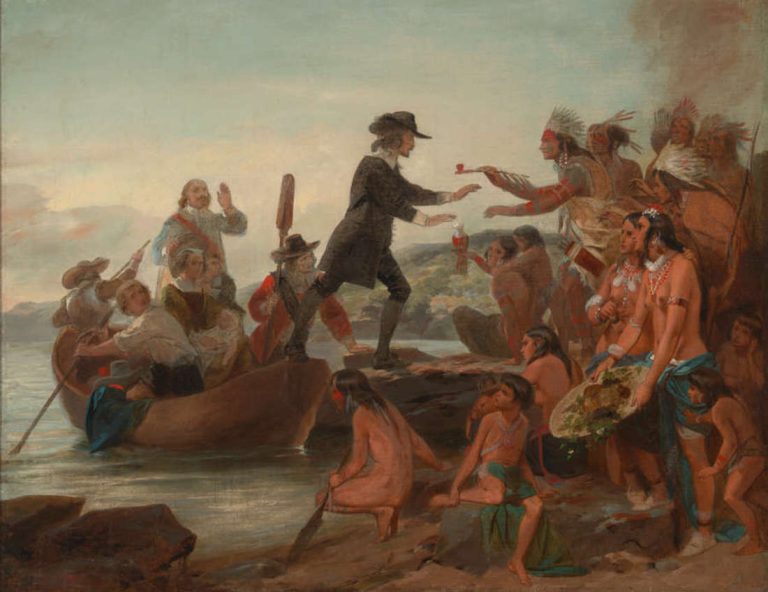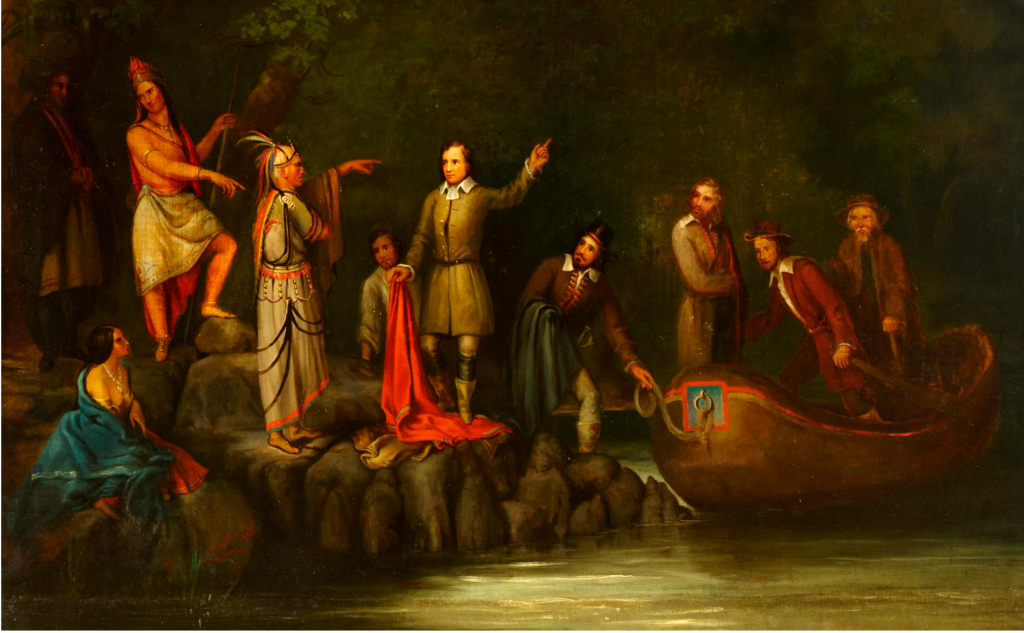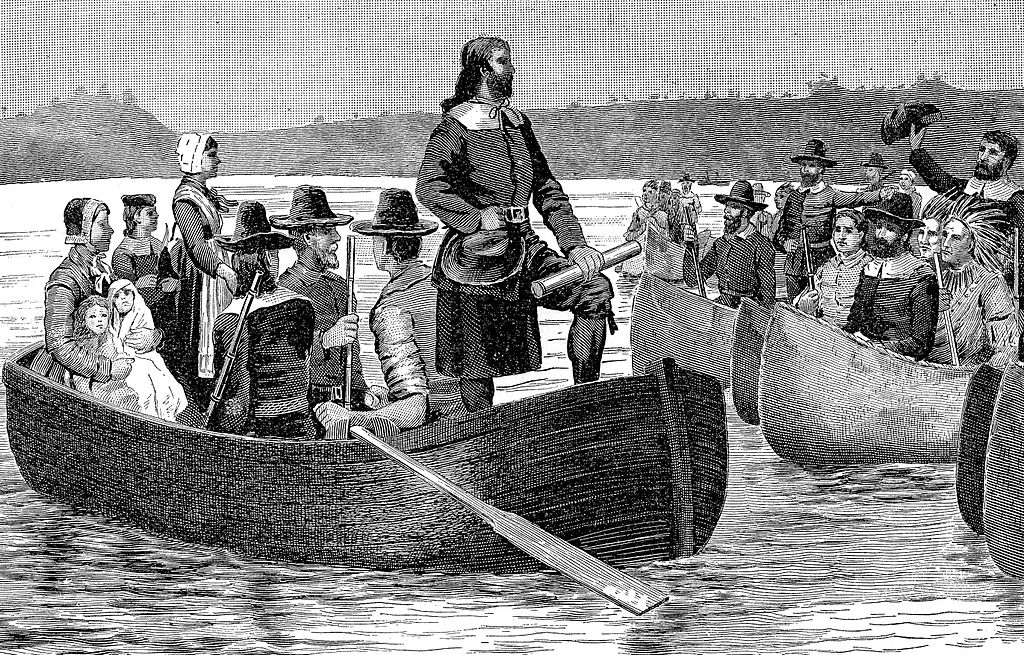
An English-born New England Puritan minister, theologian, and author who founded Providence Plantations, which became the Colony of Rhode Island and Providence Plantations and later the State of Rhode Island. He was a staunch advocate for religious freedom, separation of church and state, and fair dealings with the Native Americans. With slavery, not so much.
New York, N.Y. Rev. Roger Williams was expelled by the Puritan leaders from the Massachusetts Bay Colony for heresy, and he established Providence Plantations in 1636 as a refuge offering what he termed “liberty of conscience.” In 1638, he founded the First Baptist Church in America in Providence. Williams studied the language of the New England Native Americans and published the first book-length study of it in English.
He did not object to the enslavement of captured
enemy combatants for a fixed duration, a practice
that was the normal course of warfare in that time
Roger Williams was born in London, probably in 1603; his birth records were destroyed during the Great Fire of London. From an early age, Williams had a spiritual conversion of which his father disapproved. Williams later attended Pembroke College, Cambridge, where he received a B.A. in 1627. He demonstrated a facility with languages, acquiring familiarity with Latin, Hebrew, Greek, Dutch, and French at an early age. Years later, he tutored John Milton in Dutch and Native American languages in exchange for refresher lessons in Hebrew and Greek.
Williams took holy orders in the Church of England in connection with his studies, but he became a Puritan at Cambridge and thus ruined his chance for preferment in the Anglican church. Williams knew that Puritan leaders planned to immigrate to the New World. He did not join the first wave of settlers but later decided that he could not remain in England under the administration of Archbishop William Laud. Williams regarded the Church of England as corrupt and false, and he had arrived at the Separatist position by 1630. He and his wife boarded the Boston-bound Lyon in Bristol shortly thereafter.
On February 5, 1631, the Lyon anchored in Nantasket outside of Boston. The church of Boston offered him the opportunity to serve, but he declined the position on grounds that it was “an unseparated church.” As a Separatist, Williams considered the Church of England irredeemably corrupt and believed that one must completely separate from it to establish a new church for the true and pure worship of God.
The Salem church was also inclined to Separatism, and they invited him to become their teacher.
In response, leaders in Boston vigorously protested, leading Salem to withdraw its offer. As the summer of 1631 ended, Williams moved to Plymouth Colony, where he was welcomed and informally assisted the minister. At Plymouth, he regularly preached. Plymouth Governor William Bradford wrote that “his teachings were well approved.”
After a time, Williams decided that the Plymouth church was not sufficiently separated from the Church of England. Furthermore, his contact with the Narragansett Native Americans had caused him to question the validity of colonial charters that did not include legitimate purchase of Native American land. Governor Bradford later wrote that Williams fell “into some strange opinions which caused some controversy between the church and him.”
In 1632, Williams wrote a lengthy tract that openly condemned the King’s charters and questioned the right of Plymouth to the land without first buying it from the Native Americans. He even charged that King James had uttered a “solemn lie” in claiming that he was the first Christian monarch to have discovered the land. Williams moved back to Salem by the fall of 1633 and was welcomed as an unofficial assistant.
The Massachusetts Bay authorities were not pleased at Williams’s return.
In 1633, they summoned him to appear before the General Court in Boston to defend his tract attacking the King and the charter. The issue was smoothed out, and the tract disappeared forever, probably burned. In 1634, Williams became acting pastor of the Salem church, the minister there having died. In March 1635, he was again ordered to appear before the General Court, and he was summoned yet again for the Court’s July term to answer for “erroneous” and “dangerous opinions.” The Court finally ordered that he be removed from his church position.
Finally, the General Court tried Williams in October 1635 and convicted him of sedition and heresy.
They declared that he was spreading “diverse, new, and dangerous opinions” and ordered that he be banished. The execution of the order was delayed because Williams was ill and winter was approaching, so he was allowed to stay temporarily if he ceased publicly teaching his opinions.
He did not comply with this demand, and the sheriff came in January 1636, only to discover that he had slipped away three days earlier during a blizzard. He traveled over fifty miles on foot through deep snow, from Salem to Raynham, Massachusetts, where the local Wampanoags offered him shelter at their winter camp. Sachem Massasoit hosted Williams there for the three months until spring.

Williams crossed the Seekonk River in search of a new location suitable for settlement. Upon reaching the shore, Williams was met by Narragansett people who greeted them with the words “What cheer, Netop” (transl. Hello, friend).
The settlers then continued eastward along the Providence River, where they encountered a cove and freshwater spring. Finding the area suitable for settlement, Williams acquired the tract from the Native Americans.
Here, Williams and his followers established a new, permanent settlement, convinced that divine providence had brought them there. They named it Providence Plantations.
Williams wanted his settlement to be a haven for those “distressed of conscience,” and it soon attracted a growing number of families who did not see eye-to-eye with the leaders in Massachusetts Bay. From the beginning, a majority vote of the heads of households governed the new settlement, but only in civil things. Newcomers could also be admitted to full citizenship by a majority vote. In August 1637, a new town agreement again restricted the government to civil things.
In 1640, 39 freemen (men who had full citizenship and voting rights) signed another agreement that declared their determination “still to hold forth liberty of conscience.” Thus, Williams founded the first place in modern history where citizenship and religion were separate, providing religious liberty and separation of church and state. This was combined with the principle of majoritarian democracy.
In November 1637, the General Court of Massachusetts exiled a number of families during the Antinomian Controversy, including Anne Hutchinson and her followers.
In the meantime, the Pequot War had broken out. Massachusetts Bay asked for Williams’s help, which he gave despite his exile, and he became the Bay colony’s eyes and ears, and dissuaded the Narragansetts from joining with the Pequots. Instead, the Narragansetts allied themselves with the colonists and helped to defeat the Pequots in 1637–38.

Williams formed firm friendships and developed deep trust among the Native American tribes, especially the Narragansetts. He was able to keep the peace between the Native Americans and the Colony of Rhode Island and Providence Plantations for nearly forty years by his constant mediation and negotiation. He twice surrendered himself as a hostage to the Native Americans to guarantee the safe return of a great sachem from a summons to a court. The Native Americans trusted Williams more than any other Colonist, and he proved trustworthy.
Williams returned to London in the midst of the English Civil War.
Puritans held power in London, and he was able to obtain a charter through the offices of Sir Henry Vane the Younger despite strenuous opposition from Massachusetts’ agents. His book A Key into the Language of America proved crucial to the success of his charter, albeit indirectly. It was published in 1643 in London and combined a phrasebook with observations about life and culture as an aid to communicate with the Native Americans of New England. It covered everything from salutations to death and burial. Williams also sought to correct the attitudes of superiority displayed by the colonists towards Native Americans:
“Boast not proud English, of thy birth & blood; Thy brother Indian is by birth as Good. Of one blood God made Him, and Thee and All, As wise, as fair, as strong, as personal.”

Williams soon returned to the New World.
It took him several years to unify the settlements of Narragansett Bay under a single government. The settlements of Providence, Portsmouth, Newport, and Warwick finally united in 1647 into the Colony of Rhode Island and Providence Plantations.
Freedom of conscience was again proclaimed, and the colony became a haven for people who were persecuted for their beliefs, including Baptists, Quakers, and Jews.
Williams did not write extensively about slavery.
He consistently expressed disapproval of it, though generally he did not object to the enslavement of captured enemy combatants for a fixed duration, a practice that was the normal course of warfare in that time. Williams struggled with the morality of slavery and raised his concerns in letters to Massachusetts Bay Governor John Winthrop concerning the treatment of the Pequots during the Pequot War.
In these letters, he requested Winthrop to prevent the enslavement of Pequot women and children, as well as to direct the colonial militia to spare them during the fighting. In another letter to Winthrop written on July 31, 1637, Williams conceded that the capture and indenture of remaining Pequot women and children would “lawfully” ensure that remaining enemy combatants were “weakned and despoild,” but pleaded that their indenture not be permanent.
Despite his reservations, Williams formed part of the colonial delegation sent to conduct negotiations at the end of the Pequot War, where the fates of the captured Pequots were decided upon between the colonists of New England and their Native American allies the Narragansetts, Mohegans, and Niantics.
In 1637, Winthrop gave Williams a Pequot boy as an indentured servant.
The child had been captured by Israel Stoughton in Connecticut. Williams renamed the child “Will.”
Some of the Native American allies aided in the export of enslaved Pequots to the West Indies, while others disagreed with the practice, believing that they should have been given land and provisions to contribute to the well being of colonial settlements. Many enslaved Pequots frequently ran away, where they were taken in by surrounding Native American settlements.
Williams aided colonists in distributing and selling Pequot captives and fielded requests from colonists to track down and return runaways, using his connections with Native leaders to find escapees. Williams recorded experiences of abuse and rape recounted by the Natives he apprehended, it is speculated that Williams’s letters encouraging Winthrop to limit terms of servitude were informed by his acquaintance with escapees.
As the demand for labor in the West Indies grew with the cultivation of sugarcane, Europeans exported enslaved Native Americans to the “sugar islands.” Historian Alan Gallay estimates that between 1670 and 1715, 24,000 to 51,000 captive Native Americans were exported through Carolina ports, of which more than half, 15,000-30,000, were brought from then-Spanish Florida. These numbers were more than the number of Africans imported to the Carolinas during the same period. Gallay also says that “the trade in Indian slaves was at the center of the English empire’s development in the American South. The trade in Indian slaves was the most important factor affecting the South in the period 1670 to 1715;” intertribal wars to capture slaves destabilized English colonies, Florida and Louisiana. Additional enslaved Native Americans were exported from South Carolina to Virginia, Pennsylvania, New York, Rhode Island and Massachusetts. Starting in 1698, Parliament allowed competition among importers of enslaved Africans, raising purchase prices for slaves in Africa, so they cost more than enslaved Native Americans.
In 1641, the Massachusetts Bay Colony passed laws sanctioning slavery.
In response, under Williams’s leadership, Providence Plantations passed a law in 1652 restricting the amount of time for which an individual could be held in servitude and tried to prevent the importation of slaves from Africa. The law established terms for slavery that mirrored that of indentured servitude; enslavement was to be limited in duration and not passed down to children.
Tensions escalated with the Narragansetts during King Philip’s War, despite Williams’s efforts to maintain peace, during which his home was burned to the ground. During the war, Williams led the committee responsible for processing and selling Rhode Island’s Native American captives into slavery. Williams’s committee recommended that Providence allow residents to keep Native American slaves despite earlier municipal statutes.
The committee appraised the prices of various Native American captives and brokered their sale to residents. Williams’s son transported additional captives to be sold in Newport. Williams also organized the trial and execution of a captured Native American man who had been a ringleader in the war.
King Philip’s War (1675–1676) pitted the colonists against the Wampanoags, along with some of the Narragansetts with whom Williams had previously maintained good relations. Williams was elected captain of Providence’s militia, even though he was in his 70s. On March 29, 1676, Narragansetts burned Providence; nearly the entire town was destroyed, including Williams’s home.
Williams died sometime between January 16 and March 16, 1683 and was buried on his own property. Fifty years later, his house collapsed into the cellar and the location of his grave was forgotten.
Roger Williams of Rhode Island; Religious Freedom – with Slavery? (July 14, 2012_